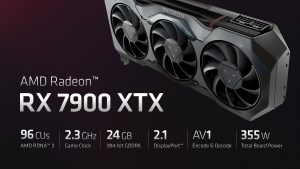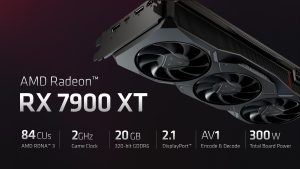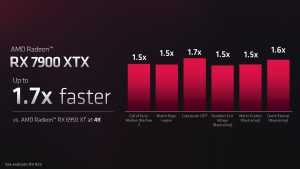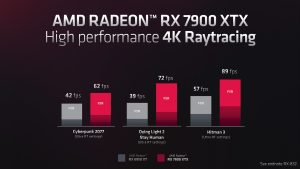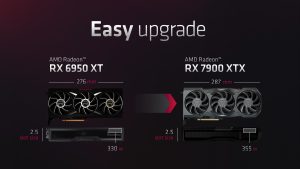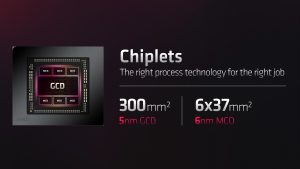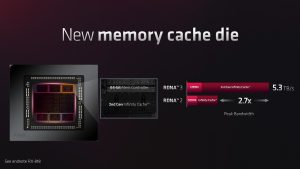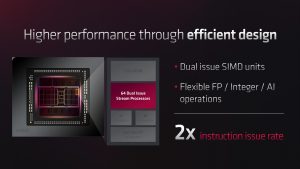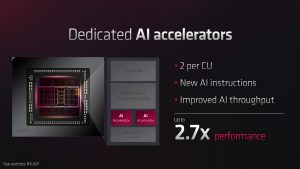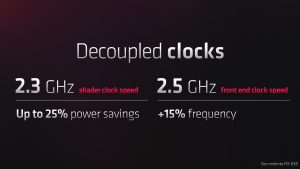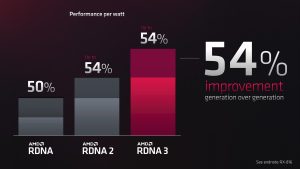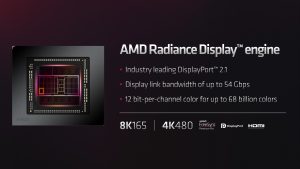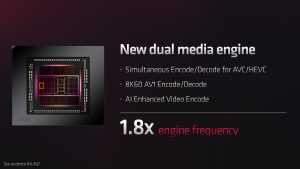AMD has today announced its new RDNA 3 architecture and the Radeon RX 7000 series at an event in Las Vegas. Featuring the world's first chiplet-based gaming GPU, the company is launching two new graphics cards on December 13th – the RX 7900 XT at $899, alongside the flagship RX 7900 XTX at $999.
Starting with a high level overview of the products themselves, AMD has announced its two highest-end graphics cards first, the Radeon RX 7900 XTX and 7900 XT. Both are built on the Navi 31 silicon, but with the 7900 XT offering slightly cut-down specs across the board.
The flagship RX 7900 XTX offers 96 Compute Units (CUs), with 64 dual-issue Stream Processors per CU resulting in a total of 6144 cores. Clock speed is rated at 2.3GHz game clock, while 24GB of GDDR6 memory is fitted across a 384-bit memory interface, assisted by 96MB of 2nd-generation Infinity Cache. Total board power (TBP) is rated at 355W.
Stepping down to the RX 7900 XT reduces the number of Compute Units to 84, for a total core count of 5376. Game clock is significantly reduced however, to a rated speed of 2GHz, while 20GB of GDDR6 memory operates over a 320-bit interface. As expected considering the reduced clocks and shader count, power draw drops to 300W TBP.
As for performance, AMD gave us a limited first look, showing relative performance for the 7900 XTX versus the RX 6950 XT over six games at 4K. The 7900 XTX is shown to be between 50-70% faster which certainly sounds like an attractive upgrade, but as always we will have to verify these numbers for ourselves. Ray tracing performance was also further shown with a look at three games, this time with FPS numbers, but do note FSR was enabled for those tests. Performance based on this slide varies from 48-85% faster than the 6950 XT, but the same caveat applies.
The keen-eyed among you will notice that performance comparisons were only shown against the 6950 XT, with no sign of the RTX 4090 in the presentation slides. In a later Q&A, AMD's Scott Herkelman stated the company is not trying to position the RX 7900 XTX to go head to head with the RTX 4090, rather saying that the new Radeon cards are ‘competing at $1000 and below.' We will have to see how that pans out in the coming weeks, with the RTX 4080 16GB set to launch November 16 for $1199.
Pricing is a key area for these cards, with the flagship coming in at $999, and you can knock off another $100 if you step down to the 7900 XT. While we won't know exactly what sort of value this represents until we can test the cards for ourselves and look at metrics such as cost per frame, the pricing is certainly aggressive relative to the 40-series. The 7900 XTX undercuts the RTX 4080 16GB by $200, and the 7900 XT would have gone head-to-head with the RTX 4080 12GB, until that SKU was ‘unlaunched.' No doubt about it, these are still expensive cards, but the price is not quite so eye-watering as I was expecting. It remains to be seen how the value perspective translates as we head down the stack, but we are unlikely to hear more about future RDNA 3 SKUs until next year.
AMD is also keen to emphasise the ‘standard' nature of the new reference card design. Making several thinly-veiled jabs at the RTX 4090, the company points out the dual 8-pin PCIe power inputs – instead of the newer 12VHPWR connector – while the 7900 XT measures 287mm long with a 2.5 slot thickness. So no power adapters needed and it should fit in all but the most compact of ITX chassis.
In terms of the new architecture, we will get a deeper dive into RDNA 3 in the coming weeks, but it was clear from the presentation that efficiency is the name of the game for RDNA 3, with numerous architectural improvements designed to offer ‘leadership' performance per Watt. Key to this is the new chiplet design, with Navi 31 packing a 300mm2 Graphics Compute die (GCD) built on a 5nm process which houses the compute units, shaders and display engine. Separate from the GCD, six 37mm2 Memory Cache die (MCD) chiplets are present, based on a 6nm node, housing a 64-bit memory controller and 16MB of Infinity Cache. While all six MCDs are physically present on the 7900 XT, one is disabled, reducing the memory interface and Infinity Cache size versus the 7900 XTX.
The Compute Unit has also been revamped, with AMD claiming a ‘gaming-optimised' approach. Foremost among this is the switch to Dual Issue Stream Processors, with each shader able to execute both floating point or Integer operations, so AMD claims a ‘2x' improvement to instruction issue rate. For the first time in an AMD GPU, the RDNA 3 architecture now includes AI Accelerators, with two per CU, while a second generation RT Accelerator is also deployed per CU. We only have a very high level overview of the new design for now, but we will follow this up with more information when possible.
Another change designed to improve efficiency comes with the move to decoupled clock speed. Instead of a single clock speed across the entirety of the GPU, RDNA 3 sees the Stream Processors clocked at 2.3GHz (for the 7900 XTX), supposedly the sweet-spot for the shaders, while the front-end clock is rated at 2.5GHz. What this will mean for overclocking remains to be seen, but AMD claims a 25% power savings from this move. Overall, RDNA 3 is slated to offer a 54% improvement to performance per Watt versus RDNA 2, something I look forward to analysing in my full review.
Lastly, a new ‘Radiance Display Engine' is present with RDNA 3, the highlight of which includes support for DisplayPort 2.1 – the first displays of which are reportedly on track to launch next year. A dual media engine is also present, including support for AV1 encode, with simultaneous encode and decode a possibility for AVI and HEVC.
For now, things are looking promising based on the early indicators. Pricing is pretty aggressive, though with the cheapest starting at $899, these are still pricey GPUs. I do find the naming unnecessarily confusing however, with the gap between the 7900 XTX and 7900 XT appearing to be greater than that of the 6900 XT and 6800 XT, yet the only difference between the naming for the new cards is a single ‘X' on the end. AMD may want to keep the 7950 XT name held back for a future refresh, but surely something more appropriate could have been put in place to differentiate the two new SKUs.
Discuss on our Facebook page HERE.
KitGuru says: RDNA 3 has arrived and AMD seems very confident in their new products. We should have further architectural details in the coming weeks, with a full review in the not too distant future.
 KitGuru KitGuru.net – Tech News | Hardware News | Hardware Reviews | IOS | Mobile | Gaming | Graphics Cards
KitGuru KitGuru.net – Tech News | Hardware News | Hardware Reviews | IOS | Mobile | Gaming | Graphics Cards


